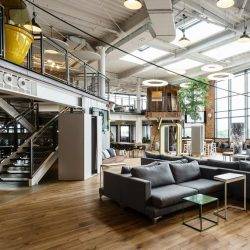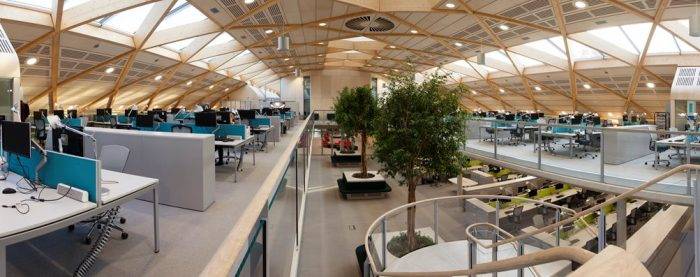 Some topics generate a level of debate totally out of proportion with the underlying facts. Whether it’s the benefit of sit-stand desks, the influence of colour on productivity or the threat (or potential) of robotics in the office, too often it’s all sizzle and no sausage. Agile working falls into that category. It’s one of those ideas that sounds too good to be true: give people a raft of settings to work in, power them up with a few mobile gadgets and you can magically transform your workspace to ‘Google standards’ and attract all the best talent in town. But what about the reality?
Some topics generate a level of debate totally out of proportion with the underlying facts. Whether it’s the benefit of sit-stand desks, the influence of colour on productivity or the threat (or potential) of robotics in the office, too often it’s all sizzle and no sausage. Agile working falls into that category. It’s one of those ideas that sounds too good to be true: give people a raft of settings to work in, power them up with a few mobile gadgets and you can magically transform your workspace to ‘Google standards’ and attract all the best talent in town. But what about the reality?
For the past couple of years, we have been running a workplace consultancy (Kinnarps Next Office) that engages leaders and employee teams in an in-depth investigation of their current work patterns and preferred workstyles if given a more agile space and more choice. Through staff workshops, an online survey and a user app, Next Office results in an understanding of how offices are currently used and how a client’s staff would like to work. This in turn informs the design process, and results in a workplace designed for and driven by staff.
Kinnarps has access to a wide range of organisations in different countries and sectors. We have now undertaken over 60 such engagements, recording the feelings and experiences of over 5,300 staff in a variety of markets.
The people have spoken
The consolidated results vary little from the individual reports, and clear themes emerge. For example:
- Office work is varied, and yet traditional workplace planning defaults to just one setting – the personal workstation. However, given the choice, people would spend less than 20 percent of their working day operating at a personal workstation.
- Most organisations have too many large, inflexible meeting rooms and not enough smaller spaces suitable for spontaneous get-togethers and project huddles.
- Despite mounting evidence that too much time spent sitting down presents significant long-term health risks, over half of workers spend little or no time standing or moving.
- The office environment plays a critical role in employees’ personal job satisfaction, and therefore offers a major opportunity for an organisation to differentiate itself from its competitors.
Meeting a need
Inadequate meeting facilities is one of the most common gripes we hear anecdotally and our surveys show that current workplace design does not meet modern needs. In general, the provision of large meeting rooms far exceeds demand: our research suggests that people would prefer smaller rooms suitable rooms for groups of 6 or less to outnumber larger ones by a ratio of almost 3:1.
Furthermore, when offered a choice of collaboration settings – such as room-in-a-room pods and project spaces – that ratio more than doubles. The age of the large conference room is being superseded by the era of smaller communication and collaboration hubs.
It starts at the top
 A common reservation among organisations considering adopting an agile workstyle is that the new facilities will go under-utilised, rendering the whole endeavour a costly waste. However, our survey shows that people consider themselves to be far more adaptable to change than their employers. On average employees rated themselves as 76% adaptable, whereas they regard their organisations as only 56 percent open to change. The clear message is that people are more open to new ideas than managers often think.
A common reservation among organisations considering adopting an agile workstyle is that the new facilities will go under-utilised, rendering the whole endeavour a costly waste. However, our survey shows that people consider themselves to be far more adaptable to change than their employers. On average employees rated themselves as 76% adaptable, whereas they regard their organisations as only 56 percent open to change. The clear message is that people are more open to new ideas than managers often think.
However, we have also found clear pitfalls in some companies’ approach to leading through the process. And the worst offenders are often at the top of the tree.
We worked with a cosmetics company in Italy whose leadership team were completely immersed in the change process. They were engaged in every step, sought their team’s ideas and embraced agile working themselves. The successful outcome was kicked off with a party they hosted to thank the staff for their input and to welcome everyone to a new way of working.
But not all organisations share this philosophy. A major client in Germany decided that going agile was ‘not for management’ and had a ‘do as I say, not as I do’ mentality. When the physical working environment was redesigned with the exclusion of the top floor, the employees asked ‘if they don’t, why should we?’ and adopted the old practices the management were hoping would change.
In order for your transition to agile to be a success, it is critical that senior management are fully on board. It must not be seen as simply a Facilities project, or even a Facilities and HR project – agile working has profound implications at every level of the business.
An agile solution that works
We recognise it’s not simply a case of choosing traditional vs agile working. You must pinpoint the degree of agility that is right for your organisation and where on the scale you should be. It works best when senior management are engaged in the process – driving the necessary changes in technology and behaviour so that the transition to agile working is a success. Investing time and effort to ensure you engage employees and generate rich data on which to make decision will help ensure that your next office is the right office for your business and your employees.
Sarah Booth is Design Manager at Kinnarps UK and is a leading practitioner in workplace design strategy. Sarah was responsible for the recent refurbishment of the Workplace House showspace in Clerkenwell, which includes a demonstration Next-Gen Project Room














April 25, 2018
A few demonstrable truths about agile working that aren’t talked about enough
by Sarah Booth • Comment, Workplace design
For the past couple of years, we have been running a workplace consultancy (Kinnarps Next Office) that engages leaders and employee teams in an in-depth investigation of their current work patterns and preferred workstyles if given a more agile space and more choice. Through staff workshops, an online survey and a user app, Next Office results in an understanding of how offices are currently used and how a client’s staff would like to work. This in turn informs the design process, and results in a workplace designed for and driven by staff.
Kinnarps has access to a wide range of organisations in different countries and sectors. We have now undertaken over 60 such engagements, recording the feelings and experiences of over 5,300 staff in a variety of markets.
The people have spoken
The consolidated results vary little from the individual reports, and clear themes emerge. For example:
Meeting a need
Inadequate meeting facilities is one of the most common gripes we hear anecdotally and our surveys show that current workplace design does not meet modern needs. In general, the provision of large meeting rooms far exceeds demand: our research suggests that people would prefer smaller rooms suitable rooms for groups of 6 or less to outnumber larger ones by a ratio of almost 3:1.
Furthermore, when offered a choice of collaboration settings – such as room-in-a-room pods and project spaces – that ratio more than doubles. The age of the large conference room is being superseded by the era of smaller communication and collaboration hubs.
It starts at the top
However, we have also found clear pitfalls in some companies’ approach to leading through the process. And the worst offenders are often at the top of the tree.
We worked with a cosmetics company in Italy whose leadership team were completely immersed in the change process. They were engaged in every step, sought their team’s ideas and embraced agile working themselves. The successful outcome was kicked off with a party they hosted to thank the staff for their input and to welcome everyone to a new way of working.
But not all organisations share this philosophy. A major client in Germany decided that going agile was ‘not for management’ and had a ‘do as I say, not as I do’ mentality. When the physical working environment was redesigned with the exclusion of the top floor, the employees asked ‘if they don’t, why should we?’ and adopted the old practices the management were hoping would change.
In order for your transition to agile to be a success, it is critical that senior management are fully on board. It must not be seen as simply a Facilities project, or even a Facilities and HR project – agile working has profound implications at every level of the business.
An agile solution that works
We recognise it’s not simply a case of choosing traditional vs agile working. You must pinpoint the degree of agility that is right for your organisation and where on the scale you should be. It works best when senior management are engaged in the process – driving the necessary changes in technology and behaviour so that the transition to agile working is a success. Investing time and effort to ensure you engage employees and generate rich data on which to make decision will help ensure that your next office is the right office for your business and your employees.
Sarah Booth is Design Manager at Kinnarps UK and is a leading practitioner in workplace design strategy. Sarah was responsible for the recent refurbishment of the Workplace House showspace in Clerkenwell, which includes a demonstration Next-Gen Project Room